Detailed Analysis: Strategic Change Management Report for EITC
VerifiedAdded on 2020/07/23
|12
|3476
|481
Report
AI Summary
This report provides an executive summary and detailed analysis of strategic change management within the Emirates Integrated Telecommunication Company (EITC). It explores various change management models, including Lewin's, Deming's PDCA cycle, and the ADKAR model, and their relevance to the current economic climate. The report examines strategic intervention techniques such as conflict resolution and techno-structural interventions. It identifies the need for change within EITC, driven by both internal and external factors like market competition and customer demands. The implications of resisting change are also discussed, along with systems to involve stakeholders using the 4 C engagement process (Communicate, Consult, Collaborate, Co-create). Strategies for managing change resistance and models to understand organizational challenges are presented, along with methods for implementing and monitoring the change process. The report emphasizes the importance of stakeholder engagement and a proactive approach to change management for EITC's sustained success in the competitive telecom market.
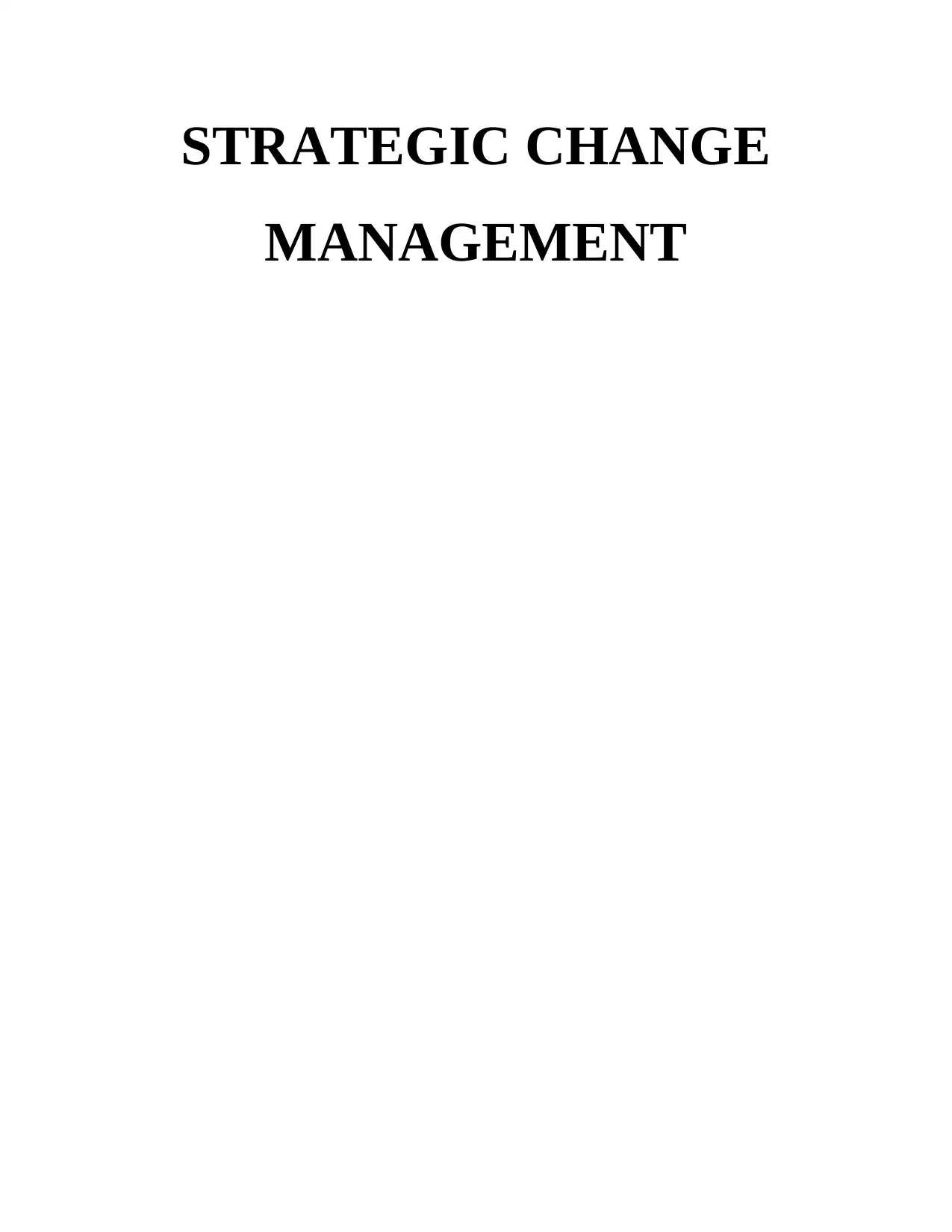
STRATEGIC CHANGE
MANAGEMENT
MANAGEMENT
Paraphrase This Document
Need a fresh take? Get an instant paraphrase of this document with our AI Paraphraser
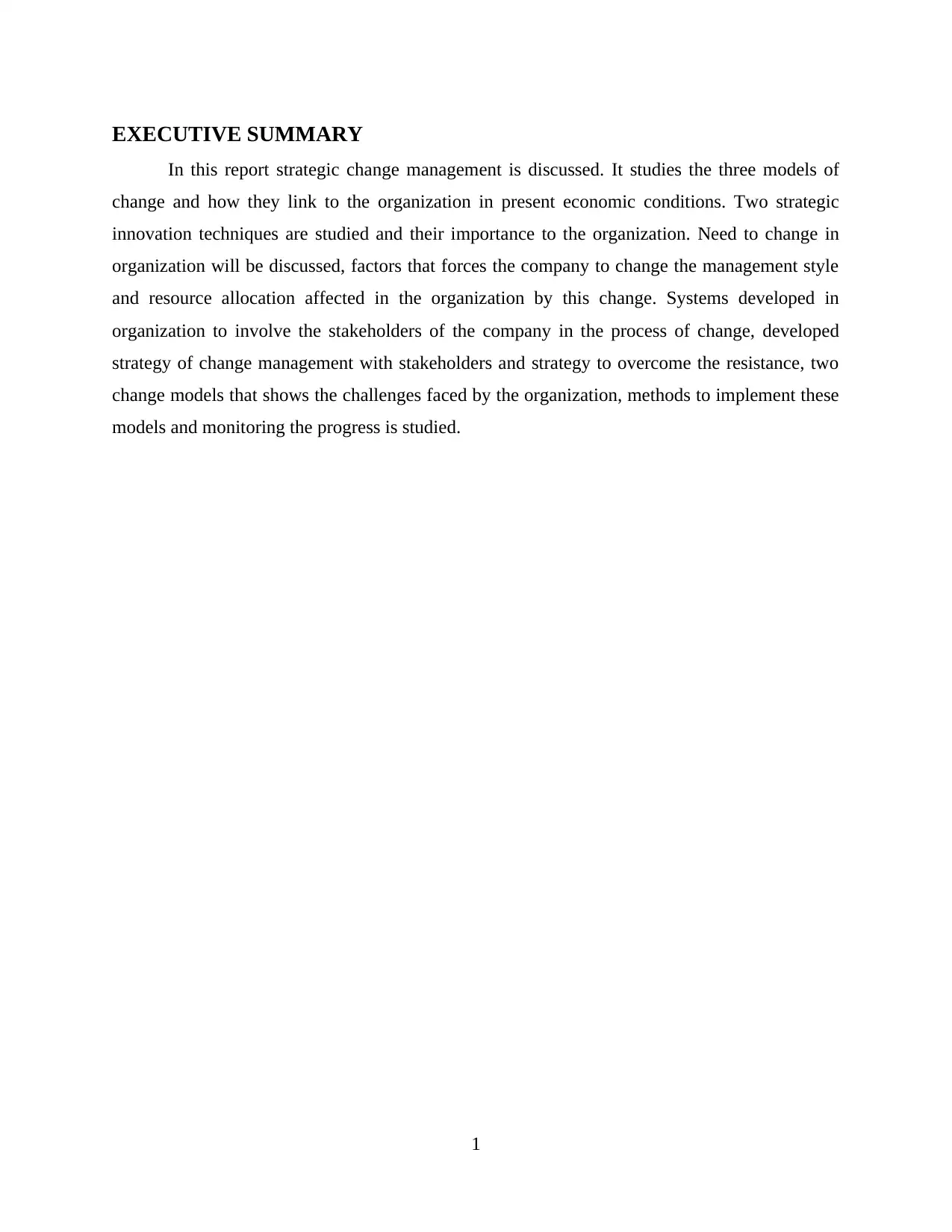
EXECUTIVE SUMMARY
In this report strategic change management is discussed. It studies the three models of
change and how they link to the organization in present economic conditions. Two strategic
innovation techniques are studied and their importance to the organization. Need to change in
organization will be discussed, factors that forces the company to change the management style
and resource allocation affected in the organization by this change. Systems developed in
organization to involve the stakeholders of the company in the process of change, developed
strategy of change management with stakeholders and strategy to overcome the resistance, two
change models that shows the challenges faced by the organization, methods to implement these
models and monitoring the progress is studied.
1
In this report strategic change management is discussed. It studies the three models of
change and how they link to the organization in present economic conditions. Two strategic
innovation techniques are studied and their importance to the organization. Need to change in
organization will be discussed, factors that forces the company to change the management style
and resource allocation affected in the organization by this change. Systems developed in
organization to involve the stakeholders of the company in the process of change, developed
strategy of change management with stakeholders and strategy to overcome the resistance, two
change models that shows the challenges faced by the organization, methods to implement these
models and monitoring the progress is studied.
1
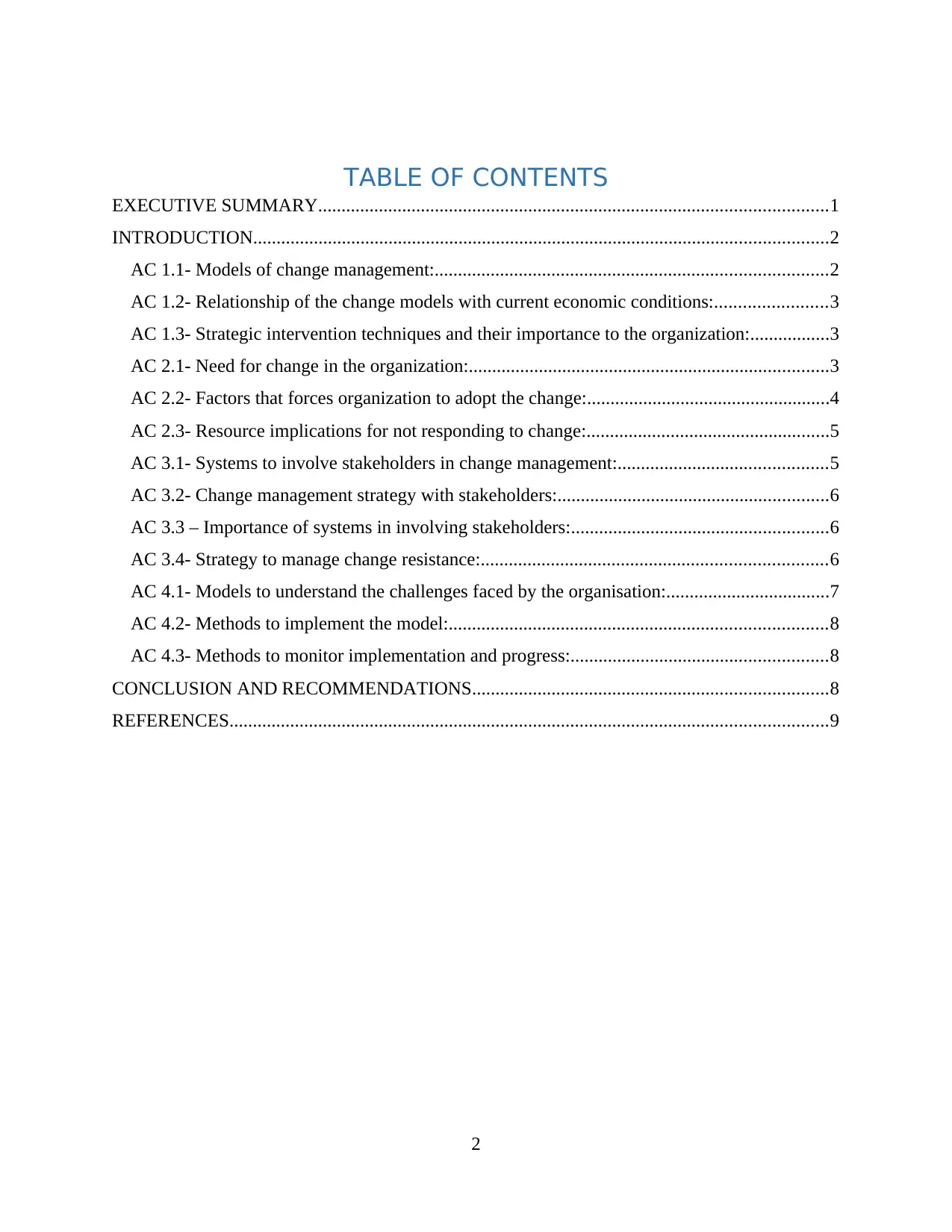
TABLE OF CONTENTS
EXECUTIVE SUMMARY.............................................................................................................1
INTRODUCTION...........................................................................................................................2
AC 1.1- Models of change management:....................................................................................2
AC 1.2- Relationship of the change models with current economic conditions:........................3
AC 1.3- Strategic intervention techniques and their importance to the organization:.................3
AC 2.1- Need for change in the organization:.............................................................................3
AC 2.2- Factors that forces organization to adopt the change:....................................................4
AC 2.3- Resource implications for not responding to change:....................................................5
AC 3.1- Systems to involve stakeholders in change management:.............................................5
AC 3.2- Change management strategy with stakeholders:..........................................................6
AC 3.3 – Importance of systems in involving stakeholders:.......................................................6
AC 3.4- Strategy to manage change resistance:..........................................................................6
AC 4.1- Models to understand the challenges faced by the organisation:...................................7
AC 4.2- Methods to implement the model:.................................................................................8
AC 4.3- Methods to monitor implementation and progress:.......................................................8
CONCLUSION AND RECOMMENDATIONS............................................................................8
REFERENCES................................................................................................................................9
2
EXECUTIVE SUMMARY.............................................................................................................1
INTRODUCTION...........................................................................................................................2
AC 1.1- Models of change management:....................................................................................2
AC 1.2- Relationship of the change models with current economic conditions:........................3
AC 1.3- Strategic intervention techniques and their importance to the organization:.................3
AC 2.1- Need for change in the organization:.............................................................................3
AC 2.2- Factors that forces organization to adopt the change:....................................................4
AC 2.3- Resource implications for not responding to change:....................................................5
AC 3.1- Systems to involve stakeholders in change management:.............................................5
AC 3.2- Change management strategy with stakeholders:..........................................................6
AC 3.3 – Importance of systems in involving stakeholders:.......................................................6
AC 3.4- Strategy to manage change resistance:..........................................................................6
AC 4.1- Models to understand the challenges faced by the organisation:...................................7
AC 4.2- Methods to implement the model:.................................................................................8
AC 4.3- Methods to monitor implementation and progress:.......................................................8
CONCLUSION AND RECOMMENDATIONS............................................................................8
REFERENCES................................................................................................................................9
2
⊘ This is a preview!⊘
Do you want full access?
Subscribe today to unlock all pages.

Trusted by 1+ million students worldwide
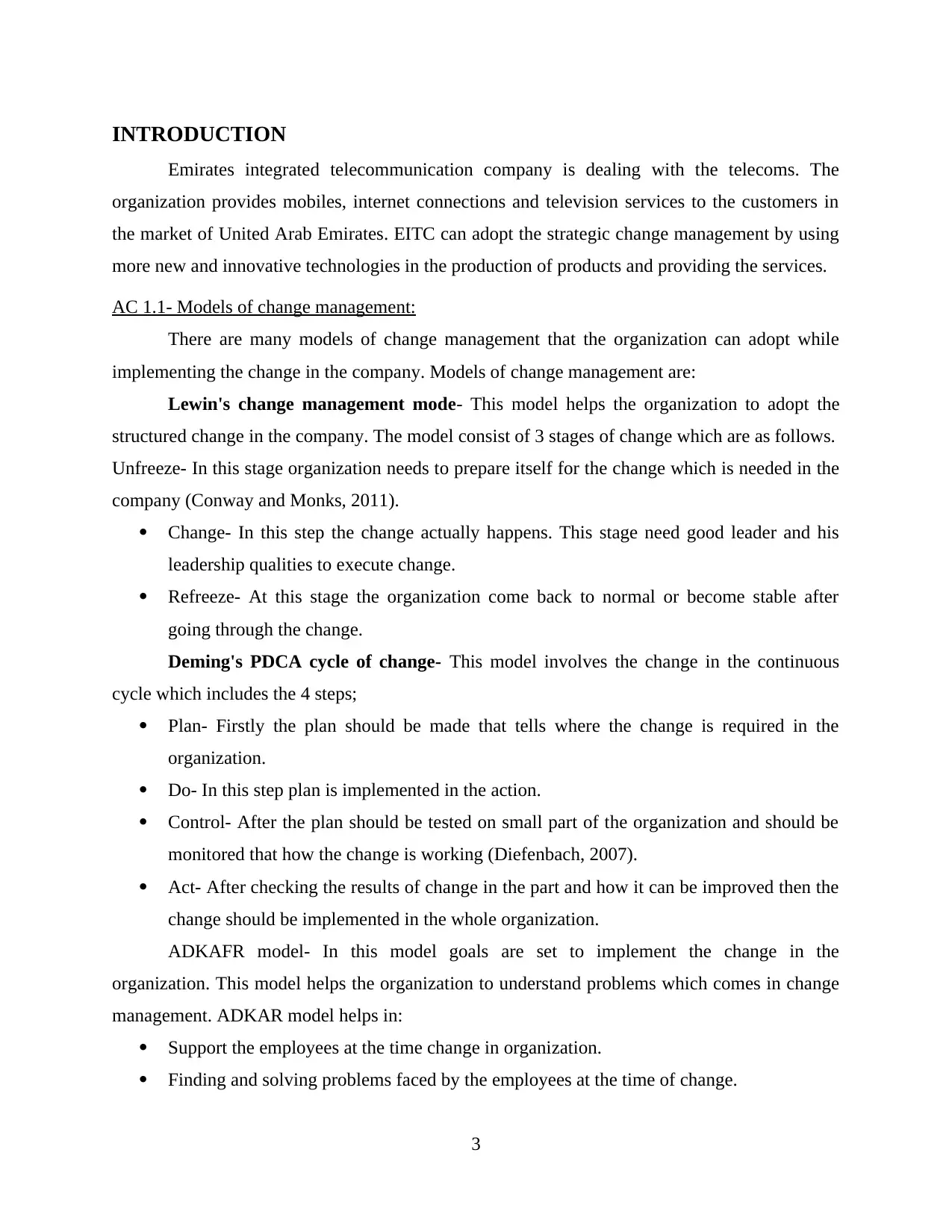
INTRODUCTION
Emirates integrated telecommunication company is dealing with the telecoms. The
organization provides mobiles, internet connections and television services to the customers in
the market of United Arab Emirates. EITC can adopt the strategic change management by using
more new and innovative technologies in the production of products and providing the services.
AC 1.1- Models of change management:
There are many models of change management that the organization can adopt while
implementing the change in the company. Models of change management are:
Lewin's change management mode- This model helps the organization to adopt the
structured change in the company. The model consist of 3 stages of change which are as follows.
Unfreeze- In this stage organization needs to prepare itself for the change which is needed in the
company (Conway and Monks, 2011).
Change- In this step the change actually happens. This stage need good leader and his
leadership qualities to execute change.
Refreeze- At this stage the organization come back to normal or become stable after
going through the change.
Deming's PDCA cycle of change- This model involves the change in the continuous
cycle which includes the 4 steps;
Plan- Firstly the plan should be made that tells where the change is required in the
organization.
Do- In this step plan is implemented in the action.
Control- After the plan should be tested on small part of the organization and should be
monitored that how the change is working (Diefenbach, 2007).
Act- After checking the results of change in the part and how it can be improved then the
change should be implemented in the whole organization.
ADKAFR model- In this model goals are set to implement the change in the
organization. This model helps the organization to understand problems which comes in change
management. ADKAR model helps in:
Support the employees at the time change in organization.
Finding and solving problems faced by the employees at the time of change.
3
Emirates integrated telecommunication company is dealing with the telecoms. The
organization provides mobiles, internet connections and television services to the customers in
the market of United Arab Emirates. EITC can adopt the strategic change management by using
more new and innovative technologies in the production of products and providing the services.
AC 1.1- Models of change management:
There are many models of change management that the organization can adopt while
implementing the change in the company. Models of change management are:
Lewin's change management mode- This model helps the organization to adopt the
structured change in the company. The model consist of 3 stages of change which are as follows.
Unfreeze- In this stage organization needs to prepare itself for the change which is needed in the
company (Conway and Monks, 2011).
Change- In this step the change actually happens. This stage need good leader and his
leadership qualities to execute change.
Refreeze- At this stage the organization come back to normal or become stable after
going through the change.
Deming's PDCA cycle of change- This model involves the change in the continuous
cycle which includes the 4 steps;
Plan- Firstly the plan should be made that tells where the change is required in the
organization.
Do- In this step plan is implemented in the action.
Control- After the plan should be tested on small part of the organization and should be
monitored that how the change is working (Diefenbach, 2007).
Act- After checking the results of change in the part and how it can be improved then the
change should be implemented in the whole organization.
ADKAFR model- In this model goals are set to implement the change in the
organization. This model helps the organization to understand problems which comes in change
management. ADKAR model helps in:
Support the employees at the time change in organization.
Finding and solving problems faced by the employees at the time of change.
3
Paraphrase This Document
Need a fresh take? Get an instant paraphrase of this document with our AI Paraphraser
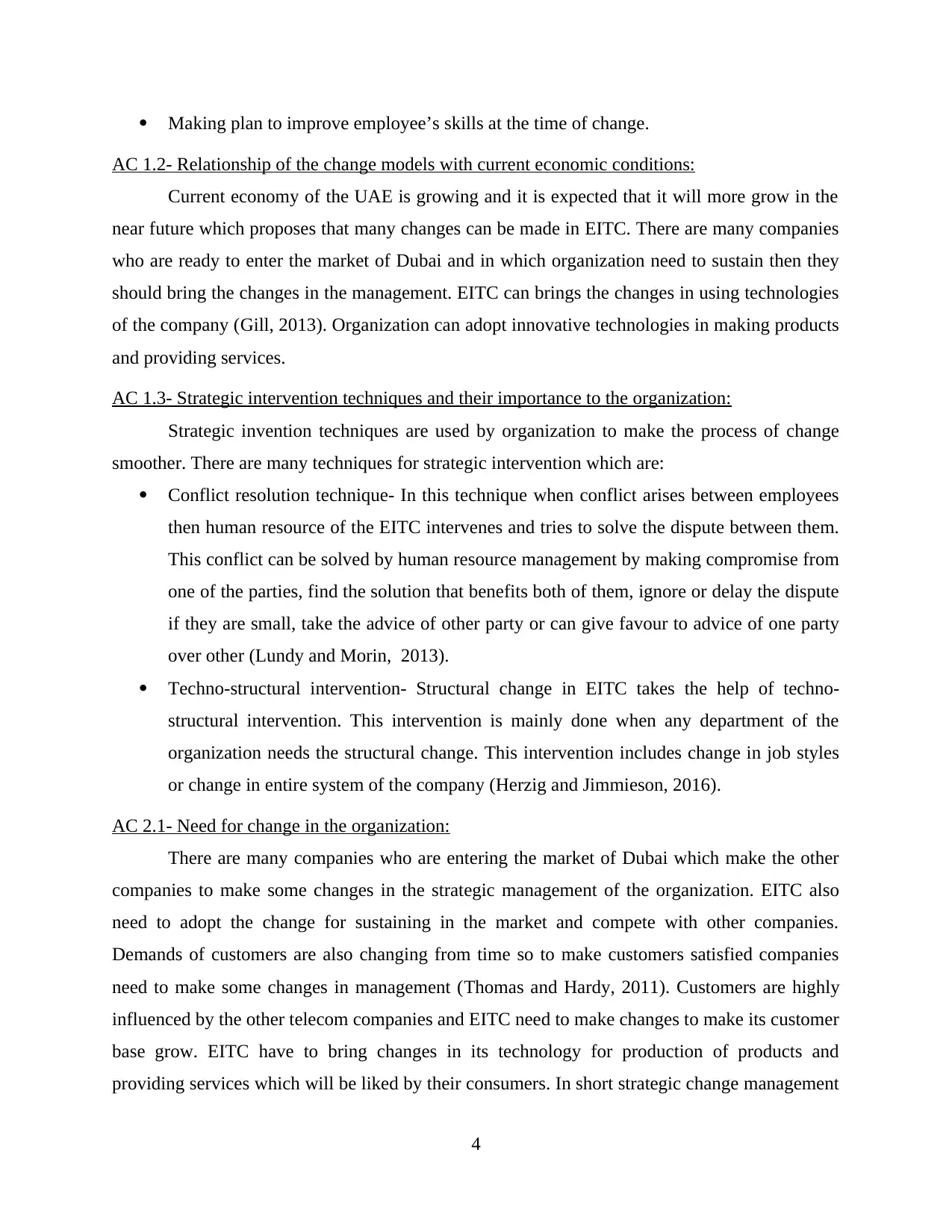
Making plan to improve employee’s skills at the time of change.
AC 1.2- Relationship of the change models with current economic conditions:
Current economy of the UAE is growing and it is expected that it will more grow in the
near future which proposes that many changes can be made in EITC. There are many companies
who are ready to enter the market of Dubai and in which organization need to sustain then they
should bring the changes in the management. EITC can brings the changes in using technologies
of the company (Gill, 2013). Organization can adopt innovative technologies in making products
and providing services.
AC 1.3- Strategic intervention techniques and their importance to the organization:
Strategic invention techniques are used by organization to make the process of change
smoother. There are many techniques for strategic intervention which are:
Conflict resolution technique- In this technique when conflict arises between employees
then human resource of the EITC intervenes and tries to solve the dispute between them.
This conflict can be solved by human resource management by making compromise from
one of the parties, find the solution that benefits both of them, ignore or delay the dispute
if they are small, take the advice of other party or can give favour to advice of one party
over other (Lundy and Morin, 2013).
Techno-structural intervention- Structural change in EITC takes the help of techno-
structural intervention. This intervention is mainly done when any department of the
organization needs the structural change. This intervention includes change in job styles
or change in entire system of the company (Herzig and Jimmieson, 2016).
AC 2.1- Need for change in the organization:
There are many companies who are entering the market of Dubai which make the other
companies to make some changes in the strategic management of the organization. EITC also
need to adopt the change for sustaining in the market and compete with other companies.
Demands of customers are also changing from time so to make customers satisfied companies
need to make some changes in management (Thomas and Hardy, 2011). Customers are highly
influenced by the other telecom companies and EITC need to make changes to make its customer
base grow. EITC have to bring changes in its technology for production of products and
providing services which will be liked by their consumers. In short strategic change management
4
AC 1.2- Relationship of the change models with current economic conditions:
Current economy of the UAE is growing and it is expected that it will more grow in the
near future which proposes that many changes can be made in EITC. There are many companies
who are ready to enter the market of Dubai and in which organization need to sustain then they
should bring the changes in the management. EITC can brings the changes in using technologies
of the company (Gill, 2013). Organization can adopt innovative technologies in making products
and providing services.
AC 1.3- Strategic intervention techniques and their importance to the organization:
Strategic invention techniques are used by organization to make the process of change
smoother. There are many techniques for strategic intervention which are:
Conflict resolution technique- In this technique when conflict arises between employees
then human resource of the EITC intervenes and tries to solve the dispute between them.
This conflict can be solved by human resource management by making compromise from
one of the parties, find the solution that benefits both of them, ignore or delay the dispute
if they are small, take the advice of other party or can give favour to advice of one party
over other (Lundy and Morin, 2013).
Techno-structural intervention- Structural change in EITC takes the help of techno-
structural intervention. This intervention is mainly done when any department of the
organization needs the structural change. This intervention includes change in job styles
or change in entire system of the company (Herzig and Jimmieson, 2016).
AC 2.1- Need for change in the organization:
There are many companies who are entering the market of Dubai which make the other
companies to make some changes in the strategic management of the organization. EITC also
need to adopt the change for sustaining in the market and compete with other companies.
Demands of customers are also changing from time so to make customers satisfied companies
need to make some changes in management (Thomas and Hardy, 2011). Customers are highly
influenced by the other telecom companies and EITC need to make changes to make its customer
base grow. EITC have to bring changes in its technology for production of products and
providing services which will be liked by their consumers. In short strategic change management
4
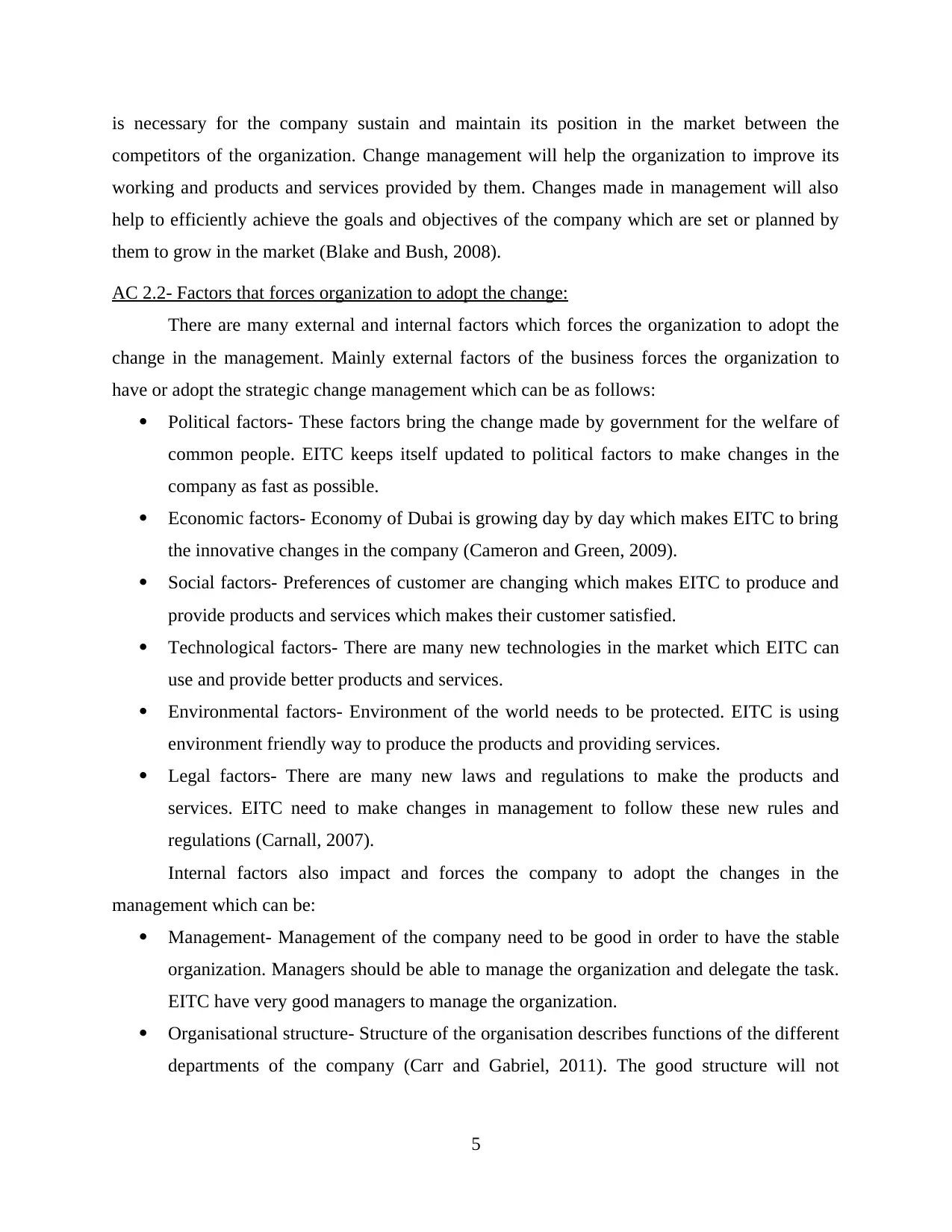
is necessary for the company sustain and maintain its position in the market between the
competitors of the organization. Change management will help the organization to improve its
working and products and services provided by them. Changes made in management will also
help to efficiently achieve the goals and objectives of the company which are set or planned by
them to grow in the market (Blake and Bush, 2008).
AC 2.2- Factors that forces organization to adopt the change:
There are many external and internal factors which forces the organization to adopt the
change in the management. Mainly external factors of the business forces the organization to
have or adopt the strategic change management which can be as follows:
Political factors- These factors bring the change made by government for the welfare of
common people. EITC keeps itself updated to political factors to make changes in the
company as fast as possible.
Economic factors- Economy of Dubai is growing day by day which makes EITC to bring
the innovative changes in the company (Cameron and Green, 2009).
Social factors- Preferences of customer are changing which makes EITC to produce and
provide products and services which makes their customer satisfied.
Technological factors- There are many new technologies in the market which EITC can
use and provide better products and services.
Environmental factors- Environment of the world needs to be protected. EITC is using
environment friendly way to produce the products and providing services.
Legal factors- There are many new laws and regulations to make the products and
services. EITC need to make changes in management to follow these new rules and
regulations (Carnall, 2007).
Internal factors also impact and forces the company to adopt the changes in the
management which can be:
Management- Management of the company need to be good in order to have the stable
organization. Managers should be able to manage the organization and delegate the task.
EITC have very good managers to manage the organization.
Organisational structure- Structure of the organisation describes functions of the different
departments of the company (Carr and Gabriel, 2011). The good structure will not
5
competitors of the organization. Change management will help the organization to improve its
working and products and services provided by them. Changes made in management will also
help to efficiently achieve the goals and objectives of the company which are set or planned by
them to grow in the market (Blake and Bush, 2008).
AC 2.2- Factors that forces organization to adopt the change:
There are many external and internal factors which forces the organization to adopt the
change in the management. Mainly external factors of the business forces the organization to
have or adopt the strategic change management which can be as follows:
Political factors- These factors bring the change made by government for the welfare of
common people. EITC keeps itself updated to political factors to make changes in the
company as fast as possible.
Economic factors- Economy of Dubai is growing day by day which makes EITC to bring
the innovative changes in the company (Cameron and Green, 2009).
Social factors- Preferences of customer are changing which makes EITC to produce and
provide products and services which makes their customer satisfied.
Technological factors- There are many new technologies in the market which EITC can
use and provide better products and services.
Environmental factors- Environment of the world needs to be protected. EITC is using
environment friendly way to produce the products and providing services.
Legal factors- There are many new laws and regulations to make the products and
services. EITC need to make changes in management to follow these new rules and
regulations (Carnall, 2007).
Internal factors also impact and forces the company to adopt the changes in the
management which can be:
Management- Management of the company need to be good in order to have the stable
organization. Managers should be able to manage the organization and delegate the task.
EITC have very good managers to manage the organization.
Organisational structure- Structure of the organisation describes functions of the different
departments of the company (Carr and Gabriel, 2011). The good structure will not
5
⊘ This is a preview!⊘
Do you want full access?
Subscribe today to unlock all pages.

Trusted by 1+ million students worldwide
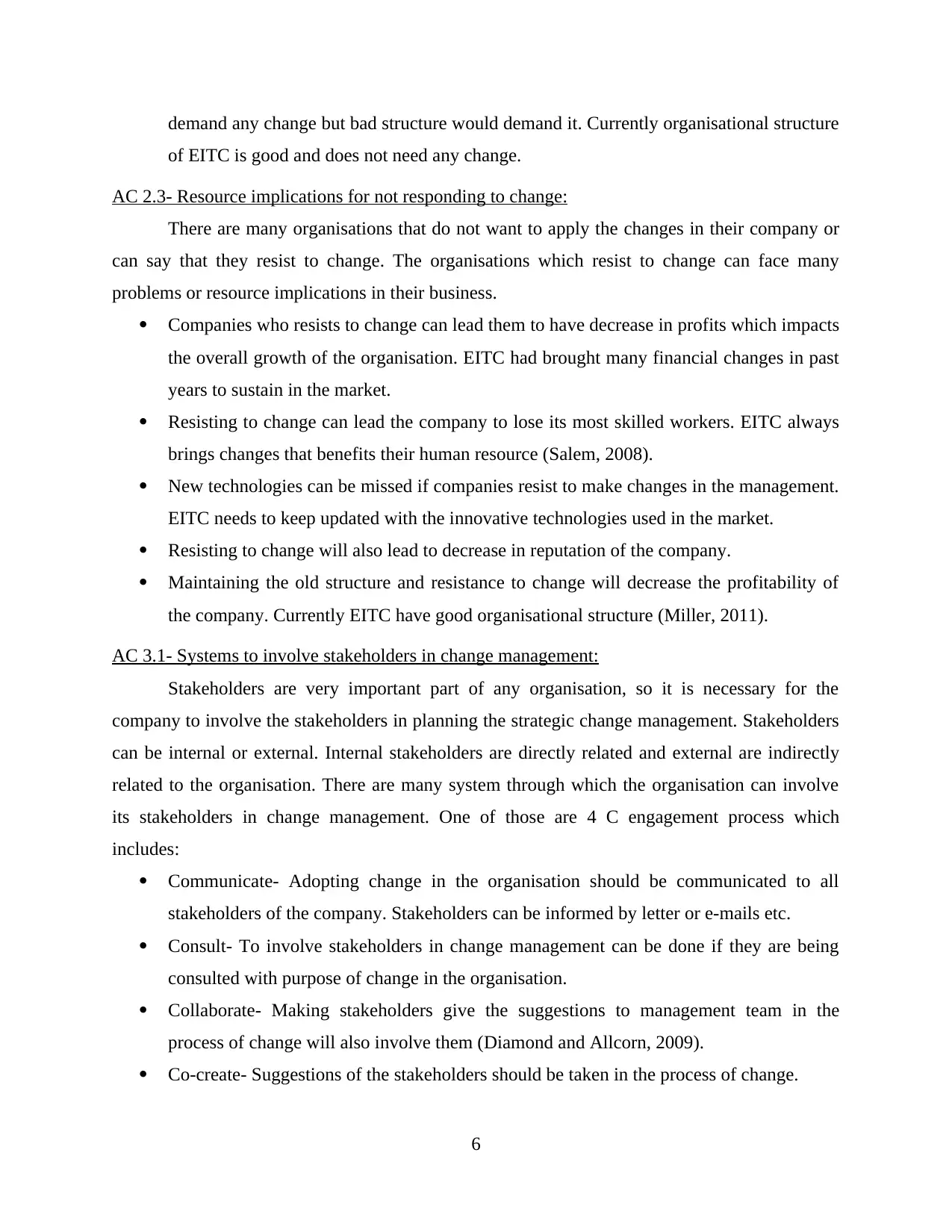
demand any change but bad structure would demand it. Currently organisational structure
of EITC is good and does not need any change.
AC 2.3- Resource implications for not responding to change:
There are many organisations that do not want to apply the changes in their company or
can say that they resist to change. The organisations which resist to change can face many
problems or resource implications in their business.
Companies who resists to change can lead them to have decrease in profits which impacts
the overall growth of the organisation. EITC had brought many financial changes in past
years to sustain in the market.
Resisting to change can lead the company to lose its most skilled workers. EITC always
brings changes that benefits their human resource (Salem, 2008).
New technologies can be missed if companies resist to make changes in the management.
EITC needs to keep updated with the innovative technologies used in the market.
Resisting to change will also lead to decrease in reputation of the company.
Maintaining the old structure and resistance to change will decrease the profitability of
the company. Currently EITC have good organisational structure (Miller, 2011).
AC 3.1- Systems to involve stakeholders in change management:
Stakeholders are very important part of any organisation, so it is necessary for the
company to involve the stakeholders in planning the strategic change management. Stakeholders
can be internal or external. Internal stakeholders are directly related and external are indirectly
related to the organisation. There are many system through which the organisation can involve
its stakeholders in change management. One of those are 4 C engagement process which
includes:
Communicate- Adopting change in the organisation should be communicated to all
stakeholders of the company. Stakeholders can be informed by letter or e-mails etc.
Consult- To involve stakeholders in change management can be done if they are being
consulted with purpose of change in the organisation.
Collaborate- Making stakeholders give the suggestions to management team in the
process of change will also involve them (Diamond and Allcorn, 2009).
Co-create- Suggestions of the stakeholders should be taken in the process of change.
6
of EITC is good and does not need any change.
AC 2.3- Resource implications for not responding to change:
There are many organisations that do not want to apply the changes in their company or
can say that they resist to change. The organisations which resist to change can face many
problems or resource implications in their business.
Companies who resists to change can lead them to have decrease in profits which impacts
the overall growth of the organisation. EITC had brought many financial changes in past
years to sustain in the market.
Resisting to change can lead the company to lose its most skilled workers. EITC always
brings changes that benefits their human resource (Salem, 2008).
New technologies can be missed if companies resist to make changes in the management.
EITC needs to keep updated with the innovative technologies used in the market.
Resisting to change will also lead to decrease in reputation of the company.
Maintaining the old structure and resistance to change will decrease the profitability of
the company. Currently EITC have good organisational structure (Miller, 2011).
AC 3.1- Systems to involve stakeholders in change management:
Stakeholders are very important part of any organisation, so it is necessary for the
company to involve the stakeholders in planning the strategic change management. Stakeholders
can be internal or external. Internal stakeholders are directly related and external are indirectly
related to the organisation. There are many system through which the organisation can involve
its stakeholders in change management. One of those are 4 C engagement process which
includes:
Communicate- Adopting change in the organisation should be communicated to all
stakeholders of the company. Stakeholders can be informed by letter or e-mails etc.
Consult- To involve stakeholders in change management can be done if they are being
consulted with purpose of change in the organisation.
Collaborate- Making stakeholders give the suggestions to management team in the
process of change will also involve them (Diamond and Allcorn, 2009).
Co-create- Suggestions of the stakeholders should be taken in the process of change.
6
Paraphrase This Document
Need a fresh take? Get an instant paraphrase of this document with our AI Paraphraser
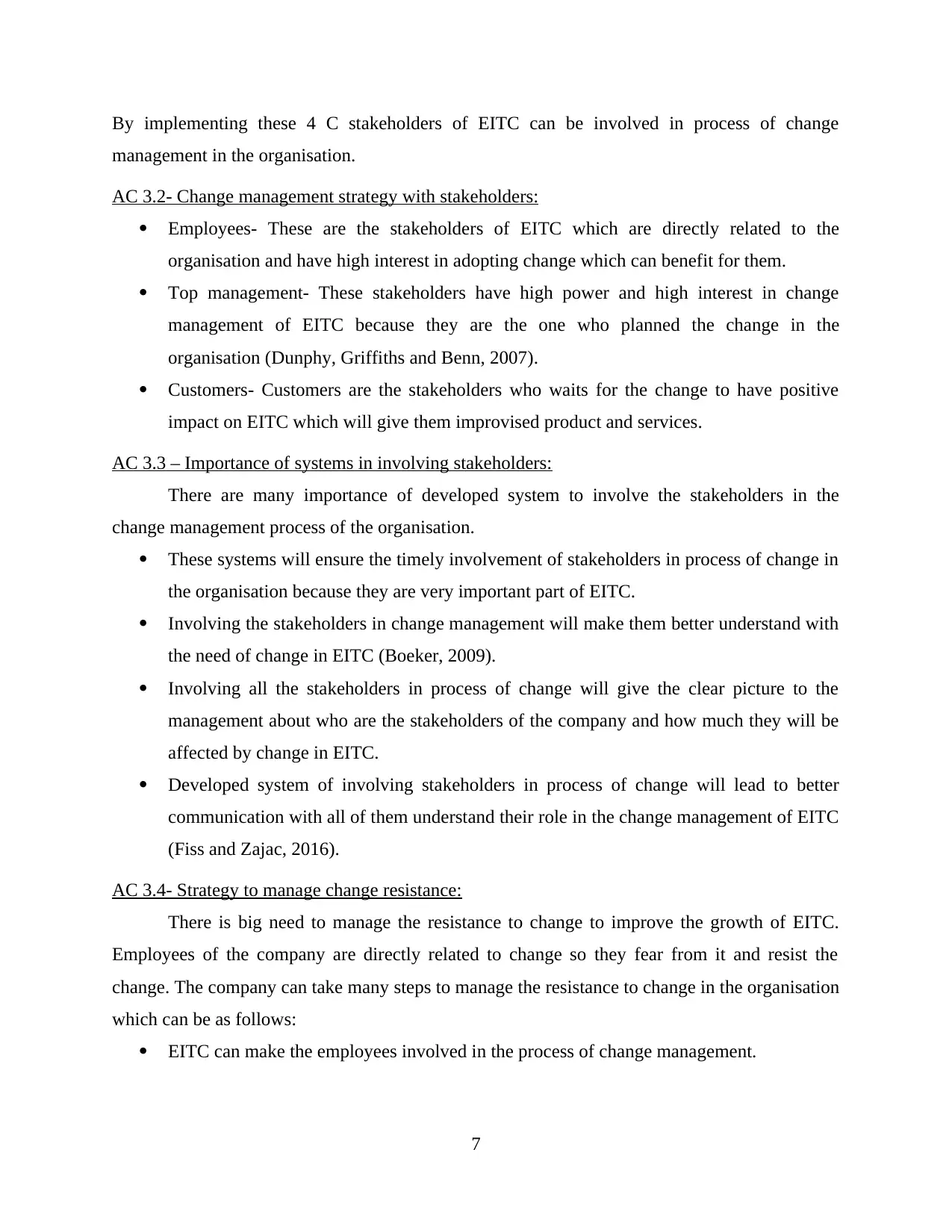
By implementing these 4 C stakeholders of EITC can be involved in process of change
management in the organisation.
AC 3.2- Change management strategy with stakeholders:
Employees- These are the stakeholders of EITC which are directly related to the
organisation and have high interest in adopting change which can benefit for them.
Top management- These stakeholders have high power and high interest in change
management of EITC because they are the one who planned the change in the
organisation (Dunphy, Griffiths and Benn, 2007).
Customers- Customers are the stakeholders who waits for the change to have positive
impact on EITC which will give them improvised product and services.
AC 3.3 – Importance of systems in involving stakeholders:
There are many importance of developed system to involve the stakeholders in the
change management process of the organisation.
These systems will ensure the timely involvement of stakeholders in process of change in
the organisation because they are very important part of EITC.
Involving the stakeholders in change management will make them better understand with
the need of change in EITC (Boeker, 2009).
Involving all the stakeholders in process of change will give the clear picture to the
management about who are the stakeholders of the company and how much they will be
affected by change in EITC.
Developed system of involving stakeholders in process of change will lead to better
communication with all of them understand their role in the change management of EITC
(Fiss and Zajac, 2016).
AC 3.4- Strategy to manage change resistance:
There is big need to manage the resistance to change to improve the growth of EITC.
Employees of the company are directly related to change so they fear from it and resist the
change. The company can take many steps to manage the resistance to change in the organisation
which can be as follows:
EITC can make the employees involved in the process of change management.
7
management in the organisation.
AC 3.2- Change management strategy with stakeholders:
Employees- These are the stakeholders of EITC which are directly related to the
organisation and have high interest in adopting change which can benefit for them.
Top management- These stakeholders have high power and high interest in change
management of EITC because they are the one who planned the change in the
organisation (Dunphy, Griffiths and Benn, 2007).
Customers- Customers are the stakeholders who waits for the change to have positive
impact on EITC which will give them improvised product and services.
AC 3.3 – Importance of systems in involving stakeholders:
There are many importance of developed system to involve the stakeholders in the
change management process of the organisation.
These systems will ensure the timely involvement of stakeholders in process of change in
the organisation because they are very important part of EITC.
Involving the stakeholders in change management will make them better understand with
the need of change in EITC (Boeker, 2009).
Involving all the stakeholders in process of change will give the clear picture to the
management about who are the stakeholders of the company and how much they will be
affected by change in EITC.
Developed system of involving stakeholders in process of change will lead to better
communication with all of them understand their role in the change management of EITC
(Fiss and Zajac, 2016).
AC 3.4- Strategy to manage change resistance:
There is big need to manage the resistance to change to improve the growth of EITC.
Employees of the company are directly related to change so they fear from it and resist the
change. The company can take many steps to manage the resistance to change in the organisation
which can be as follows:
EITC can make the employees involved in the process of change management.
7
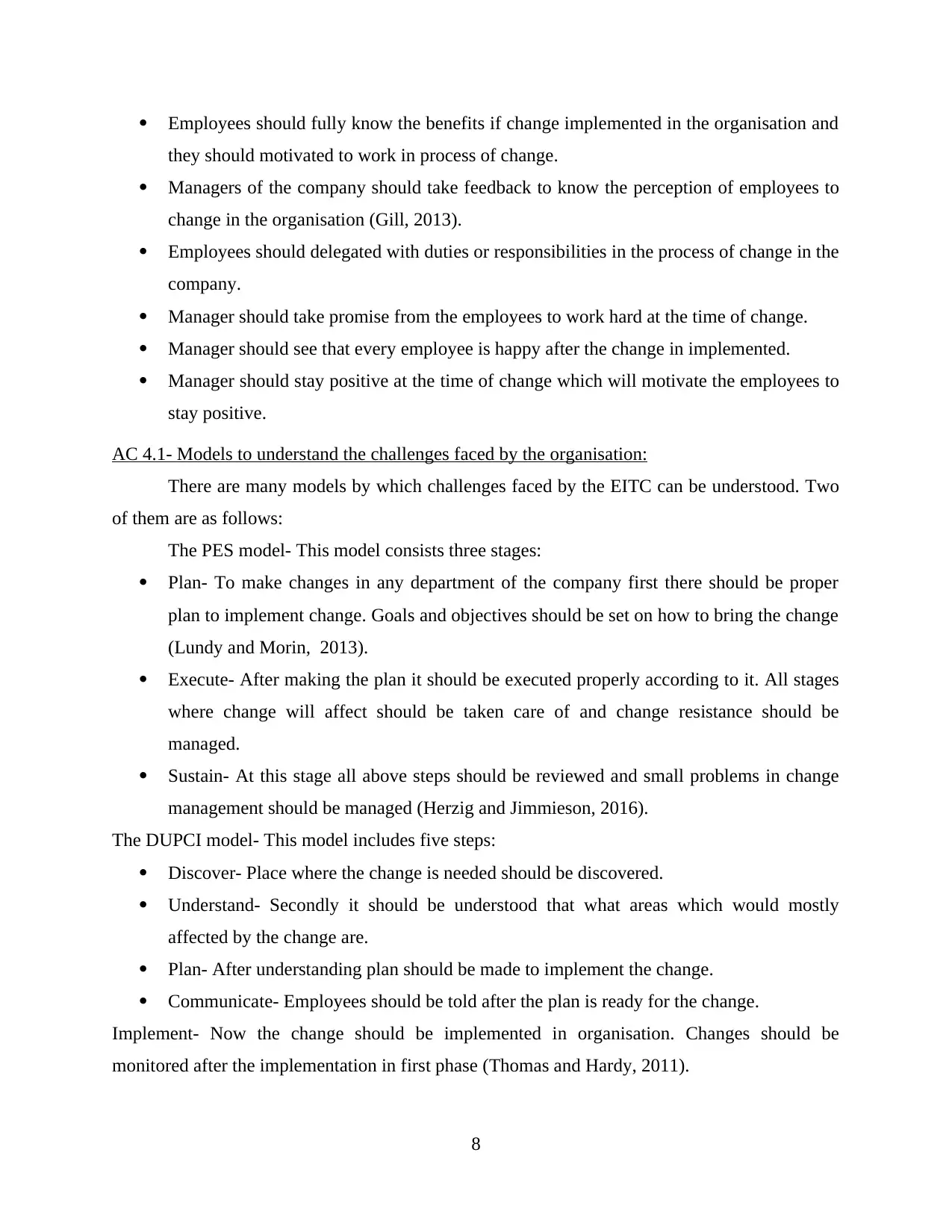
Employees should fully know the benefits if change implemented in the organisation and
they should motivated to work in process of change.
Managers of the company should take feedback to know the perception of employees to
change in the organisation (Gill, 2013).
Employees should delegated with duties or responsibilities in the process of change in the
company.
Manager should take promise from the employees to work hard at the time of change.
Manager should see that every employee is happy after the change in implemented.
Manager should stay positive at the time of change which will motivate the employees to
stay positive.
AC 4.1- Models to understand the challenges faced by the organisation:
There are many models by which challenges faced by the EITC can be understood. Two
of them are as follows:
The PES model- This model consists three stages:
Plan- To make changes in any department of the company first there should be proper
plan to implement change. Goals and objectives should be set on how to bring the change
(Lundy and Morin, 2013).
Execute- After making the plan it should be executed properly according to it. All stages
where change will affect should be taken care of and change resistance should be
managed.
Sustain- At this stage all above steps should be reviewed and small problems in change
management should be managed (Herzig and Jimmieson, 2016).
The DUPCI model- This model includes five steps:
Discover- Place where the change is needed should be discovered.
Understand- Secondly it should be understood that what areas which would mostly
affected by the change are.
Plan- After understanding plan should be made to implement the change.
Communicate- Employees should be told after the plan is ready for the change.
Implement- Now the change should be implemented in organisation. Changes should be
monitored after the implementation in first phase (Thomas and Hardy, 2011).
8
they should motivated to work in process of change.
Managers of the company should take feedback to know the perception of employees to
change in the organisation (Gill, 2013).
Employees should delegated with duties or responsibilities in the process of change in the
company.
Manager should take promise from the employees to work hard at the time of change.
Manager should see that every employee is happy after the change in implemented.
Manager should stay positive at the time of change which will motivate the employees to
stay positive.
AC 4.1- Models to understand the challenges faced by the organisation:
There are many models by which challenges faced by the EITC can be understood. Two
of them are as follows:
The PES model- This model consists three stages:
Plan- To make changes in any department of the company first there should be proper
plan to implement change. Goals and objectives should be set on how to bring the change
(Lundy and Morin, 2013).
Execute- After making the plan it should be executed properly according to it. All stages
where change will affect should be taken care of and change resistance should be
managed.
Sustain- At this stage all above steps should be reviewed and small problems in change
management should be managed (Herzig and Jimmieson, 2016).
The DUPCI model- This model includes five steps:
Discover- Place where the change is needed should be discovered.
Understand- Secondly it should be understood that what areas which would mostly
affected by the change are.
Plan- After understanding plan should be made to implement the change.
Communicate- Employees should be told after the plan is ready for the change.
Implement- Now the change should be implemented in organisation. Changes should be
monitored after the implementation in first phase (Thomas and Hardy, 2011).
8
⊘ This is a preview!⊘
Do you want full access?
Subscribe today to unlock all pages.

Trusted by 1+ million students worldwide
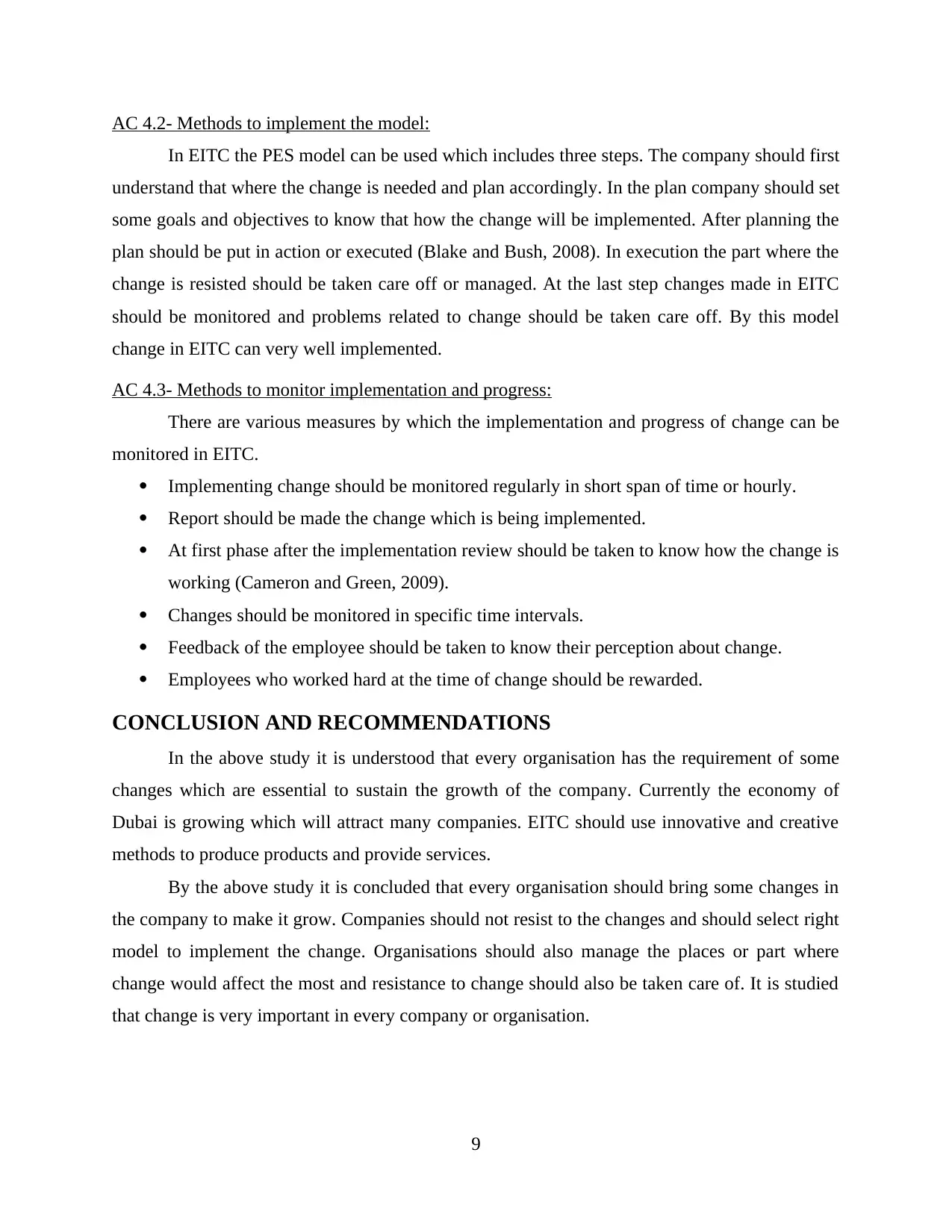
AC 4.2- Methods to implement the model:
In EITC the PES model can be used which includes three steps. The company should first
understand that where the change is needed and plan accordingly. In the plan company should set
some goals and objectives to know that how the change will be implemented. After planning the
plan should be put in action or executed (Blake and Bush, 2008). In execution the part where the
change is resisted should be taken care off or managed. At the last step changes made in EITC
should be monitored and problems related to change should be taken care off. By this model
change in EITC can very well implemented.
AC 4.3- Methods to monitor implementation and progress:
There are various measures by which the implementation and progress of change can be
monitored in EITC.
Implementing change should be monitored regularly in short span of time or hourly.
Report should be made the change which is being implemented.
At first phase after the implementation review should be taken to know how the change is
working (Cameron and Green, 2009).
Changes should be monitored in specific time intervals.
Feedback of the employee should be taken to know their perception about change.
Employees who worked hard at the time of change should be rewarded.
CONCLUSION AND RECOMMENDATIONS
In the above study it is understood that every organisation has the requirement of some
changes which are essential to sustain the growth of the company. Currently the economy of
Dubai is growing which will attract many companies. EITC should use innovative and creative
methods to produce products and provide services.
By the above study it is concluded that every organisation should bring some changes in
the company to make it grow. Companies should not resist to the changes and should select right
model to implement the change. Organisations should also manage the places or part where
change would affect the most and resistance to change should also be taken care of. It is studied
that change is very important in every company or organisation.
9
In EITC the PES model can be used which includes three steps. The company should first
understand that where the change is needed and plan accordingly. In the plan company should set
some goals and objectives to know that how the change will be implemented. After planning the
plan should be put in action or executed (Blake and Bush, 2008). In execution the part where the
change is resisted should be taken care off or managed. At the last step changes made in EITC
should be monitored and problems related to change should be taken care off. By this model
change in EITC can very well implemented.
AC 4.3- Methods to monitor implementation and progress:
There are various measures by which the implementation and progress of change can be
monitored in EITC.
Implementing change should be monitored regularly in short span of time or hourly.
Report should be made the change which is being implemented.
At first phase after the implementation review should be taken to know how the change is
working (Cameron and Green, 2009).
Changes should be monitored in specific time intervals.
Feedback of the employee should be taken to know their perception about change.
Employees who worked hard at the time of change should be rewarded.
CONCLUSION AND RECOMMENDATIONS
In the above study it is understood that every organisation has the requirement of some
changes which are essential to sustain the growth of the company. Currently the economy of
Dubai is growing which will attract many companies. EITC should use innovative and creative
methods to produce products and provide services.
By the above study it is concluded that every organisation should bring some changes in
the company to make it grow. Companies should not resist to the changes and should select right
model to implement the change. Organisations should also manage the places or part where
change would affect the most and resistance to change should also be taken care of. It is studied
that change is very important in every company or organisation.
9
Paraphrase This Document
Need a fresh take? Get an instant paraphrase of this document with our AI Paraphraser
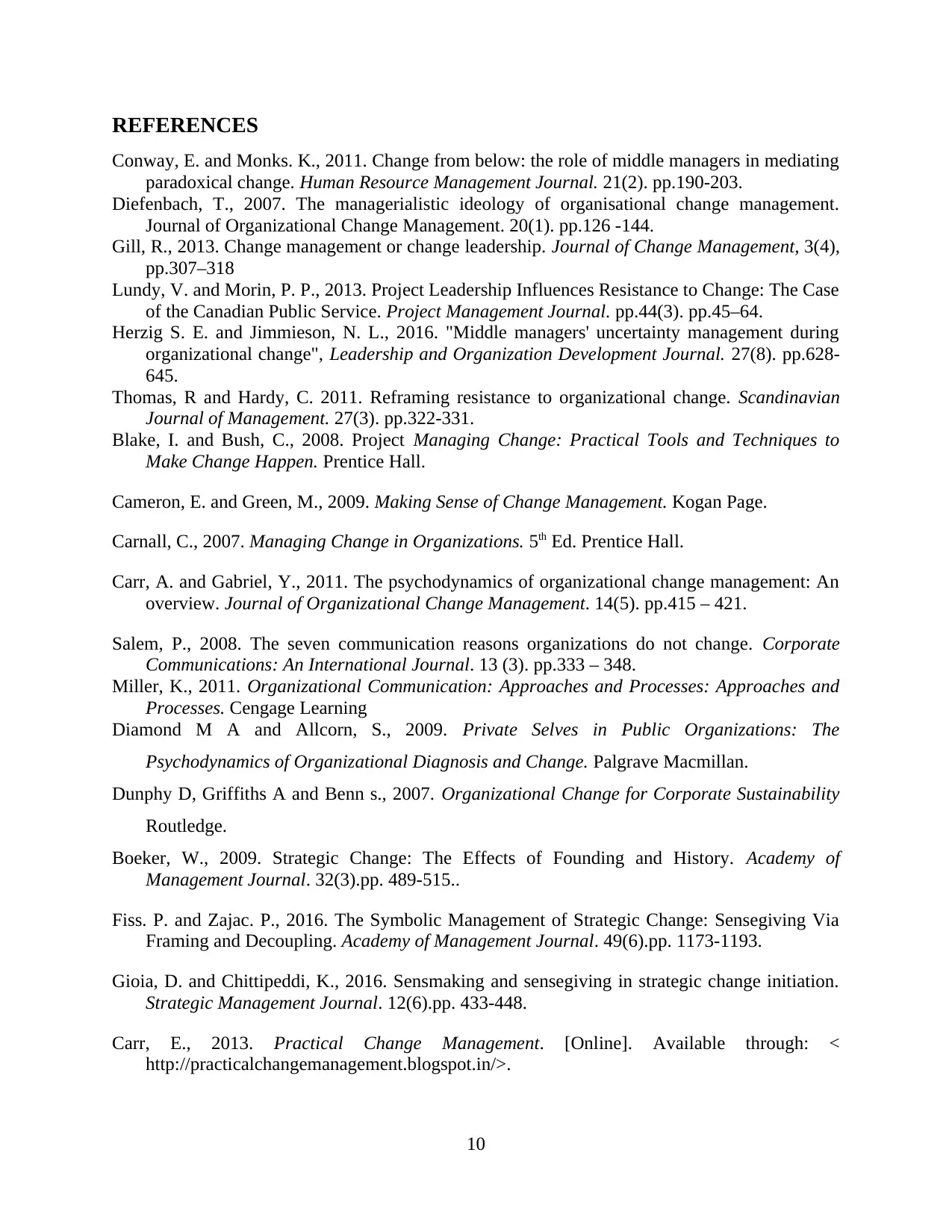
REFERENCES
Conway, E. and Monks. K., 2011. Change from below: the role of middle managers in mediating
paradoxical change. Human Resource Management Journal. 21(2). pp.190-203.
Diefenbach, T., 2007. The managerialistic ideology of organisational change management.
Journal of Organizational Change Management. 20(1). pp.126 -144.
Gill, R., 2013. Change management or change leadership. Journal of Change Management, 3(4),
pp.307–318
Lundy, V. and Morin, P. P., 2013. Project Leadership Influences Resistance to Change: The Case
of the Canadian Public Service. Project Management Journal. pp.44(3). pp.45–64.
Herzig S. E. and Jimmieson, N. L., 2016. "Middle managers' uncertainty management during
organizational change", Leadership and Organization Development Journal. 27(8). pp.628-
645.
Thomas, R and Hardy, C. 2011. Reframing resistance to organizational change. Scandinavian
Journal of Management. 27(3). pp.322-331.
Blake, I. and Bush, C., 2008. Project Managing Change: Practical Tools and Techniques to
Make Change Happen. Prentice Hall.
Cameron, E. and Green, M., 2009. Making Sense of Change Management. Kogan Page.
Carnall, C., 2007. Managing Change in Organizations. 5th Ed. Prentice Hall.
Carr, A. and Gabriel, Y., 2011. The psychodynamics of organizational change management: An
overview. Journal of Organizational Change Management. 14(5). pp.415 – 421.
Salem, P., 2008. The seven communication reasons organizations do not change. Corporate
Communications: An International Journal. 13 (3). pp.333 – 348.
Miller, K., 2011. Organizational Communication: Approaches and Processes: Approaches and
Processes. Cengage Learning
Diamond M A and Allcorn, S., 2009. Private Selves in Public Organizations: The
Psychodynamics of Organizational Diagnosis and Change. Palgrave Macmillan.
Dunphy D, Griffiths A and Benn s., 2007. Organizational Change for Corporate Sustainability
Routledge.
Boeker, W., 2009. Strategic Change: The Effects of Founding and History. Academy of
Management Journal. 32(3).pp. 489-515..
Fiss. P. and Zajac. P., 2016. The Symbolic Management of Strategic Change: Sensegiving Via
Framing and Decoupling. Academy of Management Journal. 49(6).pp. 1173-1193.
Gioia, D. and Chittipeddi, K., 2016. Sensmaking and sensegiving in strategic change initiation.
Strategic Management Journal. 12(6).pp. 433-448.
Carr, E., 2013. Practical Change Management. [Online]. Available through: <
http://practicalchangemanagement.blogspot.in/>.
10
Conway, E. and Monks. K., 2011. Change from below: the role of middle managers in mediating
paradoxical change. Human Resource Management Journal. 21(2). pp.190-203.
Diefenbach, T., 2007. The managerialistic ideology of organisational change management.
Journal of Organizational Change Management. 20(1). pp.126 -144.
Gill, R., 2013. Change management or change leadership. Journal of Change Management, 3(4),
pp.307–318
Lundy, V. and Morin, P. P., 2013. Project Leadership Influences Resistance to Change: The Case
of the Canadian Public Service. Project Management Journal. pp.44(3). pp.45–64.
Herzig S. E. and Jimmieson, N. L., 2016. "Middle managers' uncertainty management during
organizational change", Leadership and Organization Development Journal. 27(8). pp.628-
645.
Thomas, R and Hardy, C. 2011. Reframing resistance to organizational change. Scandinavian
Journal of Management. 27(3). pp.322-331.
Blake, I. and Bush, C., 2008. Project Managing Change: Practical Tools and Techniques to
Make Change Happen. Prentice Hall.
Cameron, E. and Green, M., 2009. Making Sense of Change Management. Kogan Page.
Carnall, C., 2007. Managing Change in Organizations. 5th Ed. Prentice Hall.
Carr, A. and Gabriel, Y., 2011. The psychodynamics of organizational change management: An
overview. Journal of Organizational Change Management. 14(5). pp.415 – 421.
Salem, P., 2008. The seven communication reasons organizations do not change. Corporate
Communications: An International Journal. 13 (3). pp.333 – 348.
Miller, K., 2011. Organizational Communication: Approaches and Processes: Approaches and
Processes. Cengage Learning
Diamond M A and Allcorn, S., 2009. Private Selves in Public Organizations: The
Psychodynamics of Organizational Diagnosis and Change. Palgrave Macmillan.
Dunphy D, Griffiths A and Benn s., 2007. Organizational Change for Corporate Sustainability
Routledge.
Boeker, W., 2009. Strategic Change: The Effects of Founding and History. Academy of
Management Journal. 32(3).pp. 489-515..
Fiss. P. and Zajac. P., 2016. The Symbolic Management of Strategic Change: Sensegiving Via
Framing and Decoupling. Academy of Management Journal. 49(6).pp. 1173-1193.
Gioia, D. and Chittipeddi, K., 2016. Sensmaking and sensegiving in strategic change initiation.
Strategic Management Journal. 12(6).pp. 433-448.
Carr, E., 2013. Practical Change Management. [Online]. Available through: <
http://practicalchangemanagement.blogspot.in/>.
10

11
⊘ This is a preview!⊘
Do you want full access?
Subscribe today to unlock all pages.

Trusted by 1+ million students worldwide
1 out of 12
Related Documents
Your All-in-One AI-Powered Toolkit for Academic Success.
+13062052269
info@desklib.com
Available 24*7 on WhatsApp / Email
![[object Object]](/_next/static/media/star-bottom.7253800d.svg)
Unlock your academic potential
Copyright © 2020–2025 A2Z Services. All Rights Reserved. Developed and managed by ZUCOL.





